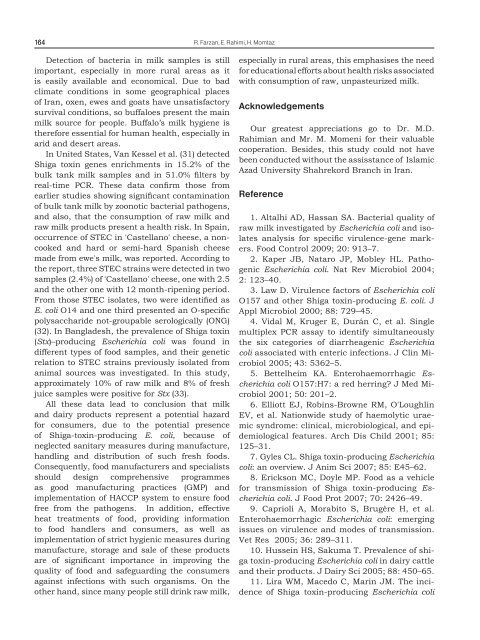SLOVENIAN VETERINARY RESEARCH
SLOVENIAN VETERINARY RESEARCH
SLOVENIAN VETERINARY RESEARCH
You also want an ePaper? Increase the reach of your titles
YUMPU automatically turns print PDFs into web optimized ePapers that Google loves.
164<br />
R. Farzan, E. Rahimi, H. Momtaz<br />
Detection of bacteria in milk samples is still<br />
important, especially in more rural areas as it<br />
is easily available and economical. Due to bad<br />
climate conditions in some geographical places<br />
of Iran, oxen, ewes and goats have unsatisfactory<br />
survival conditions, so buffaloes present the main<br />
milk source for people. Buffalo’s milk hygiene is<br />
therefore essential for human health, especially in<br />
arid and desert areas.<br />
In United States, Van Kessel et al. (31) detected<br />
Shiga toxin genes enrichments in 15.2% of the<br />
bulk tank milk samples and in 51.0% filters by<br />
real-time PCR. These data confirm those from<br />
earlier studies showing significant contamination<br />
of bulk tank milk by zoonotic bacterial pathogens,<br />
and also, that the consumption of raw milk and<br />
raw milk products present a health risk. In Spain,<br />
occurrence of STEC in 'Castellano' cheese, a noncooked<br />
and hard or semi-hard Spanish cheese<br />
made from ewe's milk, was reported. According to<br />
the report, three STEC strains were detected in two<br />
samples (2.4%) of 'Castellano' cheese, one with 2.5<br />
and the other one with 12 month-ripening period.<br />
From those STEC isolates, two were identified as<br />
E. coli O14 and one third presented an O-specific<br />
polysaccharide not-groupable serologically (ONG)<br />
(32). In Bangladesh, the prevalence of Shiga toxin<br />
(Stx)–producing Escherichia coli was found in<br />
different types of food samples, and their genetic<br />
relation to STEC strains previously isolated from<br />
animal sources was investigated. In this study,<br />
approximately 10% of raw milk and 8% of fresh<br />
juice samples were positive for Stx (33).<br />
All these data lead to conclusion that milk<br />
and dairy products represent a potential hazard<br />
for consumers, due to the potential presence<br />
of Shiga-toxin-producing E. coli, because of<br />
neglected sanitary measures during manufacture,<br />
handling and distribution of such fresh foods.<br />
Consequently, food manufacturers and specialists<br />
should design comprehensive programmes<br />
as good manufacturing practices (GMP) and<br />
implementation of HACCP system to ensure food<br />
free from the pathogens. In addition, effective<br />
heat treatments of food, providing information<br />
to food handlers and consumers, as well as<br />
implementation of strict hygienic measures during<br />
manufacture, storage and sale of these products<br />
are of significant importance in improving the<br />
quality of food and safeguarding the consumers<br />
against infections with such organisms. On the<br />
other hand, since many people still drink raw milk,<br />
especially in rural areas, this emphasises the need<br />
for educational efforts about health risks associated<br />
with consumption of raw, unpasteurized milk.<br />
Acknowledgements<br />
Our greatest appreciations go to Dr. M.D.<br />
Rahimian and Mr. M. Momeni for their valuable<br />
cooperation. Besides, this study could not have<br />
been conducted without the assisstance of Islamic<br />
Azad University Shahrekord Branch in Iran.<br />
Reference<br />
1. Altalhi AD, Hassan SA. Bacterial quality of<br />
raw milk investigated by Escherichia coli and isolates<br />
analysis for specific virulence-gene markers.<br />
Food Control 2009; 20: 913–7.<br />
2. Kaper JB, Nataro JP, Mobley HL. Pathogenic<br />
Escherichia coli. Nat Rev Microbiol 2004;<br />
2: 123–40.<br />
3. Law D. Virulence factors of Escherichia coli<br />
O157 and other Shiga toxin-producing E. coli. J<br />
Appl Microbiol 2000; 88: 729–45.<br />
4. Vidal M, Kruger E, Durán C, et al. Single<br />
multiplex PCR assay to identify simultaneously<br />
the six categories of diarrheagenic Escherichia<br />
coli associated with enteric infections. J Clin Microbiol<br />
2005; 43: 5362–5.<br />
5. Bettelheim KA. Enterohaemorrhagic Escherichia<br />
coli O157:H7: a red herring? J Med Microbiol<br />
2001; 50: 201–2.<br />
6. Elliott EJ, Robins-Browne RM, O'Loughlin<br />
EV, et al. Nationwide study of haemolytic uraemic<br />
syndrome: clinical, microbiological, and epidemiological<br />
features. Arch Dis Child 2001; 85:<br />
125–31.<br />
7. Gyles CL. Shiga toxin-producing Escherichia<br />
coli: an overview. J Anim Sci 2007; 85: E45–62.<br />
8. Erickson MC, Doyle MP. Food as a vehicle<br />
for transmission of Shiga toxin-producing Escherichia<br />
coli. J Food Prot 2007; 70: 2426–49.<br />
9. Caprioli A, Morabito S, Brugère H, et al.<br />
Enterohaemorrhagic Escherichia coli: emerging<br />
issues on virulence and modes of transmission.<br />
Vet Res 2005; 36: 289–311.<br />
10. Hussein HS, Sakuma T. Prevalence of shiga<br />
toxin-producing Escherichia coli in dairy cattle<br />
and their products. J Dairy Sci 2005; 88: 450–65.<br />
11. Lira WM, Macedo C, Marin JM. The incidence<br />
of Shiga toxin-producing Escherichia coli

















